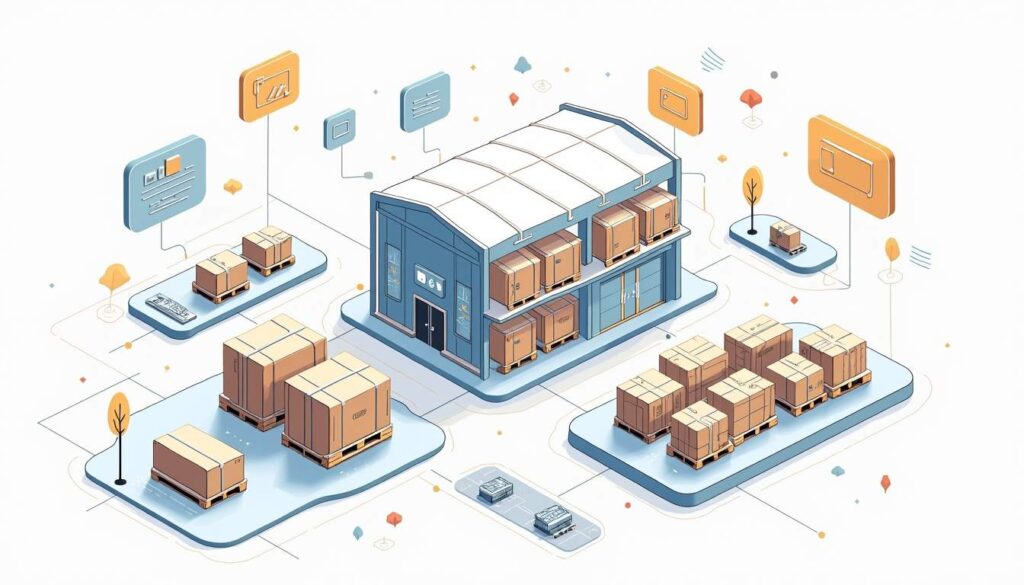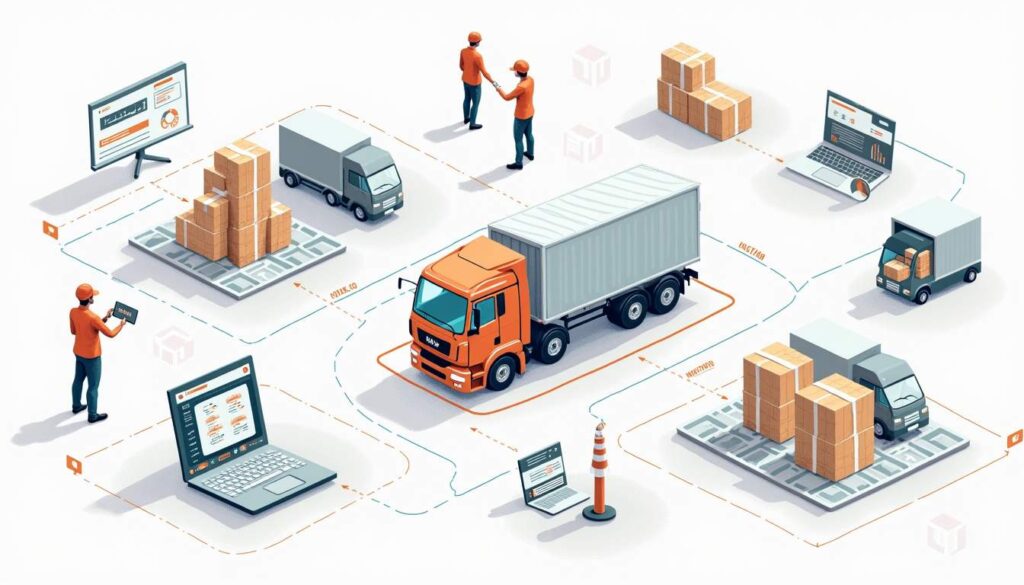Revolutionizing Supply Chain Operations with VR
VR is revolutionizing supply chain operations by providing a platform for experiential learning. Employees can engage in realistic simulations that replicate the complexities of supply chain logistics. This hands-on approach allows them to understand the nuances of their roles better.
For example, VR can simulate supply chain disruptions, such as delays or unexpected demand surges. Trainees can practice decision-making skills in a controlled environment, preparing them for real-life challenges. This proactive training approach ensures that employees are better equipped to handle crises when they arise. Additionally, these simulations can be tailored to reflect specific scenarios that a company may have encountered in the past, making the training even more relevant and impactful.
Furthermore, VR can be utilized to visualize data analytics, allowing employees to see the direct impact of their decisions on supply chain performance metrics. This integration of data visualization with immersive training can enhance understanding and foster a data-driven mindset among employees.
Measurable Outcomes of Immersive Learning
One of the most compelling aspects of VR training is its ability to produce measurable outcomes. Companies can track various metrics, such as time taken to complete tasks, error rates, and overall performance improvements.
For instance, organizations that have implemented VR training have reported a significant reduction in onboarding time for new employees. By providing immersive experiences, companies can accelerate the learning process, allowing new hires to become productive members of the team more quickly. This efficiency not only benefits the organization but also enhances the new employee’s experience, as they feel more competent and confident in their roles sooner.
Moreover, the ability to gather data on employee performance during VR training sessions can inform future training initiatives. By analyzing trends and identifying common areas of struggle, organizations can refine their training programs to address specific skill gaps and ensure that all employees receive the support they need to succeed.
Utilizing VR in Supply Chain Management
Utilizing VR in supply chain management can streamline processes and enhance operational efficiency. VR training programs can be designed to cover various aspects of supply chain management, including inventory control, demand forecasting, and supplier relationship management.
By immersing employees in realistic scenarios, they can develop a deeper understanding of how their actions impact the entire supply chain. This holistic view fosters collaboration and encourages employees to think critically about their roles within the larger context of the organization. Additionally, VR can also be used to simulate supplier negotiations, allowing employees to practice and refine their negotiation skills in a safe environment.
As a result, employees become more adept at recognizing the interconnectedness of their tasks, leading to improved communication and collaboration across departments. This interconnected approach can ultimately drive innovation and enhance the overall agility of the supply chain.
Evaluating Skills through Virtual Reality
Evaluating employee skills through VR is another innovative application that can provide valuable insights. Traditional assessment methods often fall short in accurately measuring an employee’s capabilities. However, VR can offer a dynamic and interactive way to evaluate skills in real-time.
For example, managers can observe how employees navigate through a virtual warehouse, assessing their decision-making skills and ability to respond to challenges. This data-driven approach allows organizations to identify areas for improvement and tailor training programs accordingly. In addition, VR assessments can be designed to include various scenarios that test not only technical skills but also soft skills such as teamwork and communication.
The ability to conduct assessments in a risk-free environment also encourages employees to take risks and experiment with different strategies, fostering a culture of innovation and continuous improvement within the organization.
Integrating VR into Supply Chain Training
Integrating VR into existing supply chain training programs requires careful planning and execution. Organizations need to assess their current training methods and identify areas where VR can add value.
Collaboration between training and development teams is essential to ensure that VR content aligns with organizational goals. By working together, teams can create immersive experiences that resonate with employees and enhance their learning journey. Furthermore, involving employees in the development process can provide valuable insights into their training needs and preferences, resulting in a more tailored and effective program.
Additionally, organizations should consider the technological infrastructure required to support VR training, including hardware and software needs, as well as ongoing maintenance and support. Ensuring that employees have access to the necessary tools will be critical to the success of the VR training initiative.
Enhancing New Employee Onboarding via VR
New employee onboarding is a critical phase where first impressions are formed. By incorporating VR into the onboarding process, organizations can create a memorable experience that sets the tone for the employee’s journey.
Through VR, new hires can explore the company’s facilities, learn about safety protocols, and get acquainted with their roles in a risk-free environment. This approach not only enhances the onboarding experience but also fosters a sense of belonging from day one. Furthermore, the use of VR can help new employees build relationships with their colleagues by participating in team-building exercises and collaborative tasks within the virtual environment.
Moreover, VR onboarding can be customized to reflect the specific culture and values of the organization, allowing new hires to understand the company’s mission and vision in a more engaging and impactful way. This immersive introduction can lead to higher retention rates and a more committed workforce.

Accelerating Process Implementation with VR in logistics
VR can also play a significant role in accelerating process implementation within supply chain operations. When new processes or technologies are introduced, training employees effectively is vital to ensure a smooth transition.
By using VR simulations, employees can practice new procedures in a controlled setting before applying them in real-world scenarios. This hands-on approach reduces the likelihood of errors and increases confidence among employees as they adapt to changes. Additionally, VR can facilitate “what-if” scenarios that allow employees to explore the consequences of different decisions, further enhancing their understanding of the new processes.
As a result, organizations can achieve faster adoption of new technologies and processes, leading to improved operational efficiency and a more agile supply chain. This proactive approach to training not only benefits the organization but also empowers employees to take ownership of their learning and development.
Improving Employee Training Efficiency through VR
Ultimately, the goal of any training program is to improve efficiency and productivity. VR has the potential to enhance training efficiency by providing personalized learning experiences that cater to individual needs.
With VR, employees can learn at their own pace, revisiting scenarios as needed to reinforce their understanding. This flexibility not only accommodates different learning styles but also allows for continuous improvement, as employees can practice until they feel confident in their skills. Moreover, the ability to track progress and performance metrics within the VR environment enables organizations to provide targeted feedback and support, further enhancing the learning experience.
As a result, employees are more likely to engage with the training material and apply their newfound skills effectively in their roles. This emphasis on personalized learning can lead to a more skilled and adaptable workforce, better equipped to meet the evolving demands of the supply chain industry.
Summary of Insights for VR in logistics
In conclusion, implementing VR in supply chain and logistics training offers a myriad of benefits. From revolutionizing operations to improving employee engagement and retention, the potential of VR is vast. As organizations continue to seek innovative solutions to enhance their training programs, VR stands out as a transformative tool.
By clearly defining objectives, integrating VR into existing training frameworks, and focusing on measurable outcomes, companies can unlock the full potential of this technology. As the supply chain landscape continues to evolve, embracing VR will be essential for organizations aiming to stay ahead of the curve.
In a world where efficiency and effectiveness are paramount, VR training is not just a trend; it is a strategic investment in the future of supply chain and logistics operations.
Take Your Supply Chain Training to the Next Level with SynergyXR
Ready to elevate your supply chain and logistics training with the cutting-edge technology of VR? SynergyXR is here to guide you through the transformation. We make it seamless for you to create immersive learning experiences that drive efficiency and engagement. Whether you’re in manufacturing, oil and gas, energy, construction, or production, our platform is tailored to meet your needs. Don’t miss out on the opportunity to join industry leaders in harnessing the power of extended reality.


